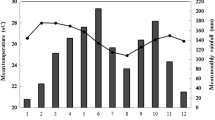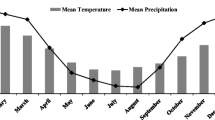Abstract
One-season fallows with legumes such as Crotalaria grahamiana Wight & Arn. and phosphorus (P) fertilization have been suggested to improve crop yields in sub-Saharan Africa. Assessing the sustainability of these measures requires a sound understanding of soil processes, especially transformations of P which is often the main limiting nutrient. We compared plant production, nitrogen (N) and P balances and selected soil properties during 5.5 years in a field experiment with three crop rotations (continuous maize, maize-crotalaria and maize-natural fallow rotation) at two levels of P fertilization (0 and 50 kg P ha−1 yr−1, applied as triple superphosphate) on a Kandiudalfic Eutrudox in western Kenya. The maize yield forgone during growth of the crotalaria fallow was compensated by higher post-fallow yields, but the cumulative total maize yield was not significantly different from continuous maize. In all crop rotations, P fertilization doubled total maize yields, increased N removal by maize and remained without effect on amounts of recycled biomass. Crotalaria growth decreased in the course of the experiment due to pest problems. The highest levels of soil organic and microbial C, N and P were found in the maize-crotalaria fallow rotation. The increase in organic P was not accompanied by a change in resin-extractable P, while H2SO4-extractable inorganic P was depleted by up to 38 kg P ha−1 (1% of total P) in the 0–50 cm layer. Microbial P increased substantially when soil was supplied with C and N in a laboratory experiment, confirming field observations that the microbial biomass is limited by C and N rather than P availability. Maize-legume fallow rotations result in a shift towards organic and microbial nutrients and have to be complemented by balanced additions of inorganic fertilizers.
Abbreviations: BNF – biological nitrogen fixation; COM – continuous maize; LR – long rainy season; MCF – maize-crotalaria fallow rotation; MNF – maize-natural fallow rotation; SR – short rainy season; TSP – triple superphosphate.
Similar content being viewed by others
References
Alef K 1995 Soil respiration. In Methods in Applied Soil Microbiology and Biochemistry. <nt>Eds.</nt> K Alef and P Nannipieri. pp. 214–219. Academic Press, London.
Anderson J M and Ingram J S I 1993 Tropical soil biology and fertility. A handbook of methods. CAB International, Wallingford, Oxon, UK. 221 pp.
Anderson T-H and Domsch K H 1990 Application of eco-physiological quotients (qCO2 and q D) on microbial biomasses from soils of different cropping histories. Soil Biol. Biochem. 22, 251–255.
Blair G J, Lefroy R D B and Lisle L 1995 Soil carbon fractions based on their degree of oxidation, and the development of a carbon management index for agricultural systems. Aust. J. Agric. Res. 46, 1459–1466.
Bühler S, Oberson A, Sinaj S, Friesen D K and Frossard E 2003 Isotope methods for assessing plant available phosphorus in acid tropical soils. Eur. J. Soil Sci. 54, 605–616.
Bünemann E K 2003 Phosphorus dynamics in a Ferralsol under maize-fallow rotations: The role of the soil microbial biomass. Ph.D. dissertation. Swiss Federal Institute of Technology, Zurich, Switzerland. 154 pp. http://e-collection.ethbib.ethz.ch/show?type=diss&nr=15207.
Chauhan B S, Stewart J W B and Paul E A 1979 Effect of carbon additions on soil labile inorganic, organic and microbially held phosphate. Can. J. Soil Sci. 59, 3877–3396.
Condron L M, Moir J O, Tiessen H and Stewart J W B 1990 Critical evaluation of methods for determining total organic phosphorus in tropical soils. Soil Sci. Soc. Am. J. 54, 1261–1266.
Desaeger J 2001 Implications of plant-parasitic nematodes for improved fallows in Africa. PhD thesis. Katholieke Universiteit Leuven, Leuven, Belgium. 216 p.
Drechsel P, Steiner K G and Hagedorn F 1996 A review on the potential of improved fallows and green manure in Rwanda. Agrofor. Syst. 33, 109–136.
Fardeau J C 1996 Dynamics of phosphate in soils. An isotopic outlook. Fert. Res. 45, 91–100.
Gathumbi S M, Cadisch G and Giller K E 2002 15 N natural abundance as a tool for assessing N 2-fixation of herbaceous, shrub and tree legumes in improved fallows. Soil Biol. Biochem. 34, 1059–1071.
Girma H 2002 Insect pest problems and their management in planted fallow crop rotation in western Kenya. PhD thesis. Kenyatta University, Nairobi, Kenya, 220 pp.
Hartemink A E, Buresh R J, Jama B and Janssen B H 1996 Soil nitrate and water dynamics in Sesbania fallows, weed fallows, and maize. Soil Sci. Soc. Am. J. 60, 568–574.
Haynes R J and Mokolobate M S 2001 Amelioration of Al toxicity and P deficiency in acid soils by additions of organic residues: A critical review of the phenomenon and the mechanisms involved. Nutr. Cycl. Agroecosys. 59, 47–63.
Jaetzold R and Schmidt H 1982 Farm Management Handbook of Kenya. Vol. II. Natural conditions and farm management information. Part A: West Kenya. Ministry of Agriculture, Kenya, in cooperation with the German Agricultural Team (GAT) of the German Agency for Technical Cooperation (GTZ), Rossdorf, Germany.
Jama B, Swinkels R A and Buresh R J 1997 Agronomic and economic evaluation of organic and inorganic sources of phosphorus in Western Kenya. Agron. J. 89, 597–604.
Kandji S T, Ogol C K P O and Albrecht A 2003 Crop damage by nematodes in improved-fallow fields in western Kenya. Agrofor. Syst. 57, 49–55.
Kouno K, Tuchiya Y and Ando T 1995 Measurement of soil microbial biomass phosphorus by an anion exchange membrane method. Soil Biol. Biochem. 27, 1353–1357.
Maroko J B, Buresh R J and Smithson P C 1998 Soil nitrogen availability as affected by fallow-maize systems on two soils in Kenya. Biol. Fert. Soils 26, 229–234.
Maroko J B, Buresh R J and Smithson P C 1999 Soil phosphorus fractions in unfertilized fallow-maize systems on two tropical soils. Soil Sci. Soc. Am. J. 63, 320–326.
McLaughlin M J, Alston A M and Martin J K 1986 Measurement of phosphorus in the soil microbial biomass: A modified procedure for field soils. Soil Biol. Biochem. 18, 437–443.
Murphy J and Riley J P 1962 A modified single solution method for the determination of phosphate in natural waters. Anal. Chim. Acta 27, 31–36.
Niang A I, Amadalo B A, de Wolf J and Gathumbi S M 2002 Species screening for short-term planted fallows in the highlands of Western Kenya. Agrofor. Syst. 56, 145–154.
Nziguheba G, Palm C A, Buresh R J and Smithson P C 1998 Soil phosphorus fractions and adsorption as affected by organic and inorganic sources. Plant Soil 198, 159–168.
Nziguheba G, Merckx R, Palm C A and Rao M R 2000 Organic residues affect phosphorus availability and maize yields in a Nitisol of western Kenya. Biol. Fert. Soils 32, 328–339.
Oberson A, Friesen D K, Tiessen H, Morel C and Stahel W 1999 Phosphorus status and cycling in native savanna and improved pastures on an acid low-P Colombian Oxisol. Nutr. Cycl. Agroecosys. 55, 77–88.
Oberson A, Friesen D K, Rao I M, Bühler S and Frossard E 2001 Phosphorus transformations in an Oxisol under contrasting land-use systems: The role of the soil microbial biomass. Plant Soil 237, 197–210.
Nziguheba G, Palm C A, Buresh R J and Smithson P C 1998 Soil phosphorus fractions and adsorption as affected by organic and inorganic sources. Plant Soil 198, 159–168.
Ohno R and Zibilske L M1991 Determination of low concentrations of phosphorus in soil extracts using malachite green. Soil Sci. Soc. Am. J. 55, 892–895.
Reid J B, Stone P J, Pearson A J and Wilson D R 2002 Yield response to nutrient supply across a wide range of conditions – 2. Analysis of maize yields. Field Crops Res. 77, 173–189.
Sanchez P A 1999 Improved fallows come of age in the tropics. Agrofor. Syst. 47, 3–12.
Saunders W M H and Williams E G 1955 Observations on the determination of total organic phosphorus in soils. J. Soil Sci. 6, 254–267.
Shang C and Tiessen H 1997 Organic matter lability in a tropical Oxisol: Evidence from shifting cultivation, chemical oxidation, particle size, density, and magnetic fractionations. Soil Sci. 162, 795–807.
Smaling E M A, Nandwa S M and Janssen B H 1997 Soil fertility in Africa is at stake. In Replenishing Soil Fertility in Africa. <nt>Eds.</nt> R J Buresh, P A Sanchez and F Calhoun. pp. 47–61. SSSA/ASA, Madison, WI.
Smestad B T, Tiessen H and Buresh R J 2002 Short fallows of Tithonia diversifolia and Crotalaria grahamiana for soil fertility improvement in western Kenya. Agrofor. Syst. 55, 181–194.
Smithson P C and Sanchez P A 2001 Plant nutritional problems in marginal soils. In Plant Nutrient Acquisition. New Perspectives. <nt>Eds.</nt> N Ae, J Arihara, K Okada and A Srinivasan. pp. 32–68. Springer, Tokyo.
Swinkels R A, Franzel S, Shepherd K D, Ohlsson E and Ndufa J K 1997 The economics of short rotation improved fallows: Evidence from areas of high population density in western Kenya. Agric. Syst. 55, 99–121.
Szott L T, Palm C A and Buresh R J 1999 Ecosystem fertility and fallow function in the humid and subhumid tropics. Agrofor. Syst. 47, 163–196.
Tran T S, Fardeau J C and Giroux M 1988 Effects of soil properties on plant-available phosphorus determined by the isotopic dilution phosphorus-32 method. Soil Sci. Soc. Am. J. 52, 1383–1390.
van Noordwijk M 1999 Productivity of intensified crop-fallow rotations in the Trenbath model. Agrofor. Syst. 47, 233–237.
Vance E D, Brookes P C and Jenkinson D S 1987 An extraction method for measuring soil microbial biomass C. Soil Biol. Biochem. 19, 703–707.
Author information
Authors and Affiliations
Rights and permissions
About this article
Cite this article
Bünemann, E., Smithson, P., Jama, B. et al. Maize productivity and nutrient dynamics in maize-fallow rotations in western Kenya. Plant Soil 264, 195–208 (2004). https://doi.org/10.1023/B:PLSO.0000047749.43017.fd
Issue Date:
DOI: https://doi.org/10.1023/B:PLSO.0000047749.43017.fd




